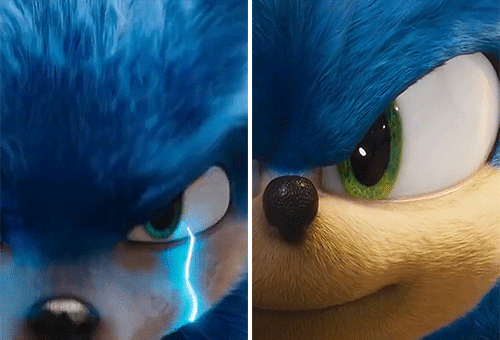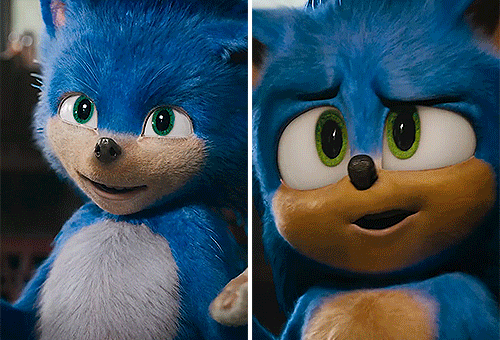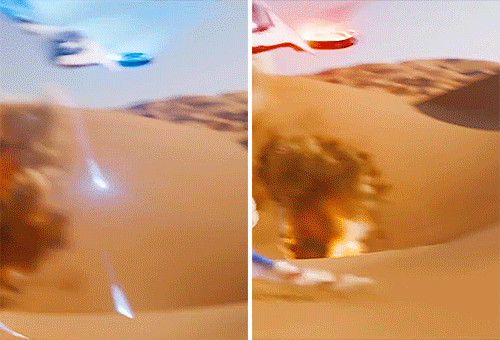
THE SONIC MOVIE CONSPIRACY
A SENIOR THESIS BY MCKENZIE MOORE
DECEMBER 2019

Background
The Sonic the Hedgehog franchise began when SEGA of Japan launched their own flagship series to compete with Nintendo's market, creating the video game "Sonic the Hedgehog" in 1991. What followed was now nearly 30 years of a primarily video game franchise, with additional media built around Sonic's character: comics, television shows, anime, web series, etc. The character quickly became one of the most popular video game icons in history.
Despite a wide and diverse Sonic media presence, there was never an official Sonic the Hedgehog feature film. In 2013, Sony Pictures obtained the rights to use Sonic's character for a film, and Paramount Pictures then acquired the rights in 2017, with the film's production team and cast remaining mostly the same. A November 2019 release date was announced, and on April 30th, 2019, the first trailer for "Sonic the Hedgehog" was revealed.
The Reaction and the Redesign
The first trailer was met with enormous criticism from the Sonic fanbase and general public. Viewers were alarmed by Sonic's humanoid, uncanny valley-esque appearance, and a widespread Internet backlash swept across social media. After the largely negative reaction, director Jeff Fowler announced on his Twitter (seen below) on May 2, 2019 that Sonic would be redesigned and the release date was moved to February 14, 2020 to allow animators enough time to make the change.



via Twitter
On November 12, 2019. the second trailer was released, revealing Sonic's redesign and more exposition for the movie's plot. The new trailer and Sonic's redesign were met with an overwhelmingly positive response, with fans expressing their gratitude and support for the studio and approval of the new Sonic. The comparison between the first and second trailers quickly became a meme, such as the ones seen here:

via Catchy Memes

via Tumblr
Looking at the audience reaction from a hypodermic needle theory lens, the knee-jerk response to the first trailer showed that it had a fairly direct impact on the audience. This can be attributed either to psychological factors involved in human response to animation, and/or to the emotional factors involved in the loyalty people have in a fandom to the proper portrayal of a character, especially in a fandom as old as Sonic's.
However, the collective action taken by the fandom demonstrates a more active audience theory -- the Sonic fandom and general public had a specific idea in mind for a Sonic feature film, and when the trailer had a negative effect by failing to meet that expectation, the audience took to social media to demand change. The audience successfully utilized its place as one of the factors affecting media content and caused a studio to make a complete turnaround on a film's primary aspect.
However, some members of the public and fandom don't see it that way.
The Conspiracy Theory
When the new trailer was released, most of the fandom expressed appreciation and happiness over the change. However, some proposed this conspiracy theory about the movie, similar to theories about New Coke in 1985:
The "redesign" was the official design the whole time. The design seen in the first "Sonic the Hedgehog" trailer was purposely terrible in order to create bad press that Paramount could later use to build additional hype for the movie when the second trailer was released.
While this conspiracy circulates primarily on Tumblr (such as the two posts in the Sonic tag seen below), it has also spread to other social media platforms -- namely Twitter, where the official Sonic the Hedgehog account sees a lot of engagement (see Jeremy Gordon's tweet below):

via Tumblr

via Tumblr

via Twitter
Fans backing the theory say that using a red herring approach generated publicity outside of the Sonic fandom and created free marketing for Paramount by initiating a widespread Internet conversation. The original design on its own, as well as the comparison of it to the redesign, is also the subject of an ever-growing supply of memes -- not only is the Sonic fandom already deeply-rooted in meme culture (the official Sonic Twitter even mentions memes in their bio) but memes are quickly becoming a creative marketing resource.

data gathered via Twitter
I conducted a Twitter poll to see how the fandom and general public felt about the motivation behind the redesign. The results are seen to the left: most believed it was a result of fandom collective action, while the second largest portion felt that Paramount was avoiding a box office flop after the reaction to the first trailer. A minority either believed the redesign is a result of the marketing conspiracy or didn't commit to an answer.
However, the data isn't perfectly representative because it took place only on my Twitter (which doesn't have the biggest following). Many of the conspiracy theorists -- and a large portion of the Sonic fandom -- reside on Tumblr. This is true of most fandoms: they tend to flock toward one platform, and collective opinions change based on that platform.
"I don't think it was the plan all along to make him ugly then change it, but I think they saw an opportunity to raise the profile of an otherwise underwhelming movie." -- Voter, on why they chose "a publicity stunt"
So What's Real?
With multiple mixed feelings and confusion about what exactly happened with the Sonic movie redesign, I aim to clear some things up. After the research process, I have come to this conclusion:
The Sonic movie redesign was not a publicity stunt. A combination of collective action from the fandom and Paramount's decision to avoid a projected box office flop prompted the complete redesign of Sonic. Here's why.
1. Movie Production Timeline
Seen here is a tweet from Tyson Hesse, the designer for Sonic Mania and lead designer for the new Sonic movie design. One of the arguments for the conspiracy is that it would've been impossible to make such a fast redesign. But with the typical timeline for CGI/live-action films, it's likely that the clips of the original Sonic design seen in the first trailer were most of the fully-rendered shots, meaning the animation team only had to redesign a few minutes' worth of the film.

via Twitter
2. CGI Animation Process
In CGI animation, usually the animation process involves creating a basic model and moving it into various environments, then adding posing and movement. Fine-tuned details (such as quills) are added in later. Due to this process, the redesign process for Sonic (while it still would be tedious and time-consuming) required the creation of a new base model, then simply replacing the old model with the new one. The most time-consuming aspect would be re-working the new model to properly fit in with the environments around it, as well as adjustments for the model's interaction with objects and other characters. This can be seen in shot-by-shot comparisons of certain scenes from both trailers:



3. Budget
However, even if the animation team didn't redesign the entire movie, it still involved a great deal of turnaround that ended up costing Paramount Pictures around 5 million dollars, adding about 5.5% to an estimated 90 million dollar production budget for the film.

data via IMDb
As seen here, compared to other recent CGI/live-action films, "Sonic the Hedgehog" has a fairly small budget. Assuming that animating the "extra" footage for the first trailer cost the same as redesigning the segments, stacking an additional $5 million onto an already tight budget seems like an unreasonable financial risk on a marketing stunt that may or may not work, especially considering the film had already spent a marketing budget on advertising and promotional merchandise with the original design.
"For my money (or gold rings), this conspiracy theory doesn’t really stack up – spending millions on trailers, merchandise and posters that would have to be scrapped, expensively shifting a release date and advertising your incompetence to the world might not be worth the chance of people being pleasantly surprised by your second attempt."
-- Huw Fullerton, RadioTimes
4. Merchandise
To continue on that note, images of exclusive theater cup toppers using the original design were leaked, and a Halloween costume featuring the original design on the packaging has already been in production, both seen here:

via Tumblr

via Nintendo Wire
Rarely are Halloween costumes made for a film coming out the next year, and creating merchandise, promotional posters, and widespread advertising for the first part of a bait-and-switch seems excessive, especially considering all of it would ultimately need to be reproduced again for the redesign.
5. Release Date
Most family and action movies are released during summer months from May to July, with another sweep taking place during the late calendar year to take advantage of successful holiday weekends at the box office. "Sonic the Hedgehog" was originally planned to release on November 8, 2019, opening up the holiday season and preceding films like "Frozen II" and "Star Wars Episode IX."
Delaying the film's release not only caused a backtrack in marketing, but put "Sonic the Hedgehog" in the middle of the winter dump months. Due to awards criteria, winter weather, and conflict with work and school starting back up after the holidays, movies typically avoid January-March for releases, as that time frame rarely yields profitable box office results. Valentine's Day is also usually reserved for the release of romance movies, not family action/adventure films.
Paramount Pictures most likely wouldn't have given up a holiday release and exchanged it for a less than ideal opening weekend unless the studio genuinely needed the extra time to make the redesign.
6. Tyson Hesse
Tyson Hesse, one of the designers for Sonic Mania, was brought in to lead the redesign for the Sonic movie. Before signing on with SEGA, Hesse was a Sonic fan and an active member of the fandom by creating popular webcomics. He has directly spoken out about the conspiracy theory on Twitter. Here is his official announcement as well as some examples of his replies to the theorists:

via Twitter

via Twitter

via Twitter

via Twitter
Conclusion
According to the data and perspectives I have presented here, the Sonic movie redesign was not a marketing conspiracy. The motivation behind the redesign could have been either box office concerns from Paramount or collective action by the public and the Sonic fandom; most likely, it was a combination of both. But while the conspiracy theory may not hold up, there's still a valuable lesson to learn from the situation.
Tyson Hesse's design was most likely so well-received because Hesse himself is a Sonic fan. The studio's decision to give the fanbase a direct role in the film was controversial, but it ultimately resulted in a design that the majority of the public was pleased with, and it will likely improve the movie's box office performance. It leaves a lot to be explored in terms of how fans are involved with the creative process behind a franchise. For me, I think the whole thing can be seen as a testament to a fandom's loyalty and how important it is for that passion to be present behind the scenes.
Sources
-
Brown, Tom. “Prototype Sonic Movie Merchandise Shows What Could Have Been.” Nintendo Wire, 28 July 2019. Web accessed.
-
Claiborn, Samuel. “Sonic the Hedgehog: A History of SEGA's Mascot in Games, Movies, and More.” IGN, 12 Nov. 2019. Web accessed.
-
Cole, Aidan. “More Than A Trend: Meme Marketing Is Here To Stay.” Forbes, Forbes Magazine, 19 July 2018. Web accessed.
-
Eberle, Scott G. “Exploring the Uncanny Valley to Find the Edge of Play.” American Journal of Play, vol. 2, no. 2, 2009. Web accessed.
-
Fullerton, Huw. “No, Sonic's New Look Isn't a Conspiracy – but We Could All Learn from It.” Radio Times, 14 Nov. 2019. Web accessed.
-
Haoues, Rachid. “30 Years Ago Today, Coca-Cola Made Its Worst Mistake.” CBS News, CBS Interactive, 23 Apr. 2015. Web accessed.
-
Kuei, Breuce, and Doug Dooley. “Animated Movies: You Asked, Pixar Answers.” Youngzine, 31 Mar. 2011. Web accessed.
-
McWhertor, Michael. “The Origins of Sonic the Hedgehog.” Polygon, 21 Mar. 2018. Web accessed.
-
Park, Gene. “Analysis | We're Surprised Too: Sonic the Hedgehog's New Look Actually Works. Here's Why.” The Washington Post, 12 Nov. 2019. Web accessed.
-
Rohlf, Bradley M. “Audience Reactions to Computer-Generated Imagery in Video.” Knowledge Repository @ IUP: Theses and Dissertations, Aug. 2017. Web accessed.
-
Sharf, Zack. “'Sonic' Redesign Cost Paramount Nowhere Near the $35 Million That's Been Rumored.” IndieWire, 18 Nov. 2019. Web accessed.
-
Shaver, Allen. “CGI Animation Process.” Animation Academy, 2011. Web accessed.
-
Stuart, Keith. “The New Sonic the Hedgehog Movie Trailer Is a Giant Relief.” The Guardian, Guardian News and Media, 12 Nov. 2019. Web accessed.
-
TV Tropes. “Dump Months.” Web accessed.

Additional Sources
Disclaimer: Some links may be broken as changes are made to external content from the time of this presentation. The links will remain to preserve the original process of this project.
Mckenzie Moore
Colorado Mesa University
MASS 494 - Senior Seminar and Research
Presented December 2, 2019